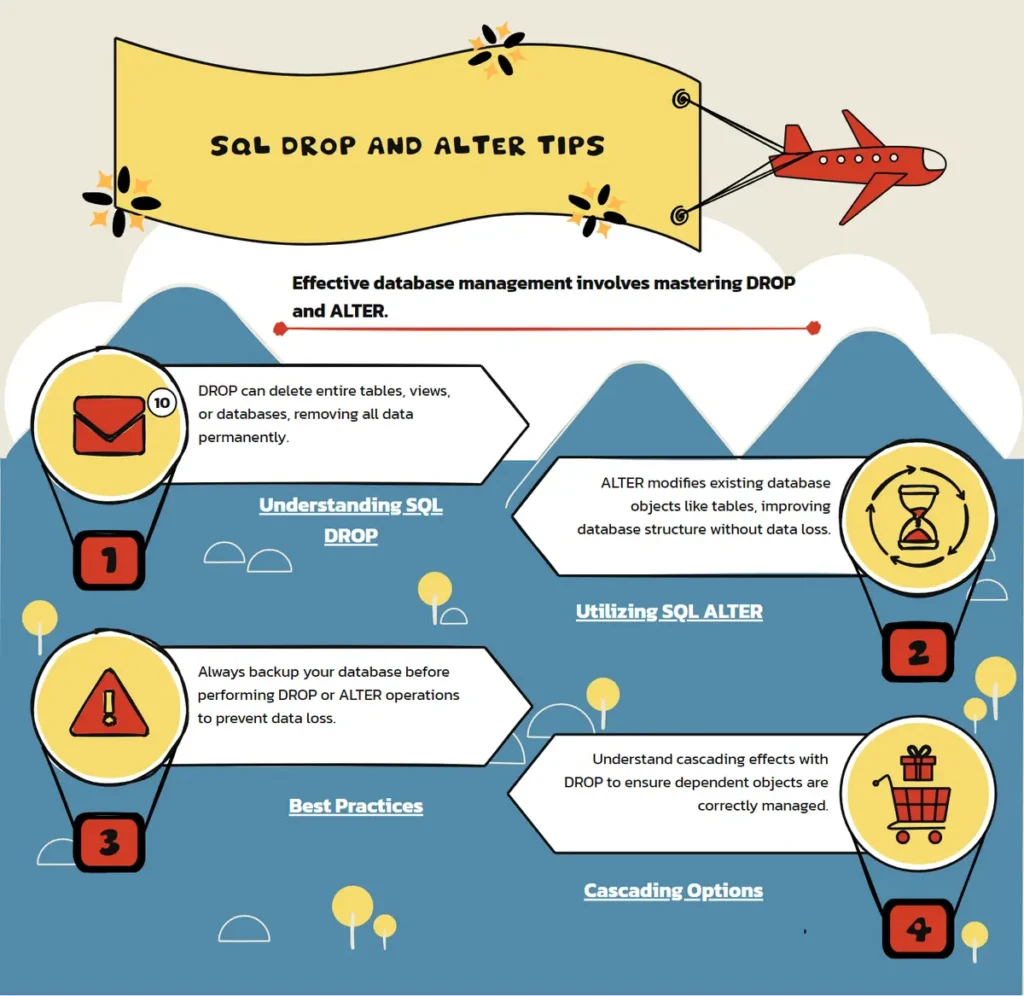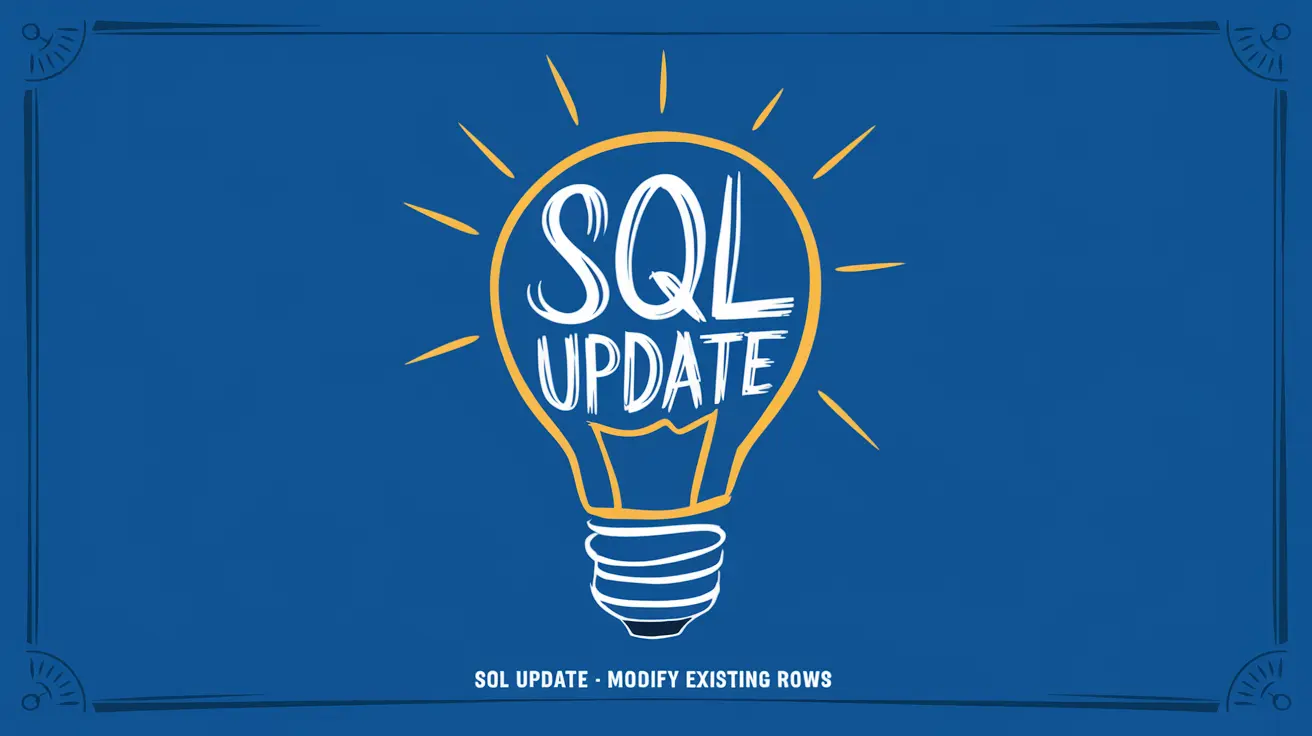Are you ready to take your database management skills to the next level? Understanding SQL DROP and ALTER commands is crucial for efficiently modifying table structures. Let’s dive into these powerful tools that can transform your approach to database manipulation.
Introduction to SQL Table Modifications
Database management is a dynamic process. As your business evolves, so do your data needs. SQL provides robust commands to adapt your database structure: DROP and ALTER. These tools allow you to remove unnecessary tables and modify existing ones with precision.
Why are these commands so important? They give you the flexibility to:
- Remove outdated tables
- Add new columns to existing tables
- Modify data types
- Rename tables or columns
Let’s explore each command in detail and see how they can streamline your database operations.

The Power of SQL DROP: Removing Tables and Objects
The SQL DROP command is your go-to tool for removing database objects. It’s simple yet powerful, allowing you to delete tables, indexes, views, and more.
Here’s a basic syntax for dropping a table:
DROP TABLE table_name;For example, to remove a table named “old_customers”:
DROP TABLE old_customers;Be cautious! This command permanently deletes the table and all its data. There’s no undo button, so double-check before executing.
Some databases offer a safer option:
DROP TABLE IF EXISTS old_customers;This prevents errors if the table doesn’t exist.
SQL ALTER TABLE: Reshaping Your Database Structure
While DROP removes entire tables, ALTER modifies existing ones. It’s like renovating a house instead of demolishing it.
The ALTER TABLE command can:
- Add new columns
- Modify existing columns
- Rename columns or tables
- Add or remove constraints
Let’s look at some examples:
Adding a new column:
ALTER TABLE customers
ADD COLUMN email VARCHAR(100);Modifying a column’s data type:
ALTER TABLE products
MODIFY COLUMN price DECIMAL(10,2);Renaming a column:
ALTER TABLE employees
RENAME COLUMN emp_name TO full_name;These commands give you the power to adapt your tables as your needs change.
Common Use Cases for DROP and ALTER Commands
When might you use these commands? Here are some real-world scenarios:
- Removing temporary tables after data migration
- Adding a new customer attribute to your database
- Changing a column’s data type to accommodate larger values
- Renaming tables for better clarity
For instance, imagine you’re expanding your e-commerce platform. You might need to add a “reviews” column to your products table:
ALTER TABLE products
ADD COLUMN reviews TEXT;Or perhaps you’re consolidating databases and need to remove duplicate tables:
DROP TABLE old_orders;
DROP TABLE outdated_inventory;These commands make such changes quick and efficient.
Best Practices for Safe Table Modifications
While powerful, DROP and ALTER can be dangerous if misused. Follow these best practices:
- Always backup your database before major changes
- Use transactions for complex operations
- Test commands on a development database first
- Use the IF EXISTS clause with DROP to prevent errors
- Document all structural changes for future reference
Here’s an example of using a transaction:
BEGIN TRANSACTION;
ALTER TABLE customers
ADD COLUMN loyalty_points INT;
-- Check if the operation was successful
IF @@ERROR = 0
COMMIT;
ELSE
ROLLBACK;This approach ensures that changes are only applied if everything works correctly.
Advanced Techniques: Combining DROP and ALTER for Efficiency
For complex restructuring, combining DROP and ALTER can be highly effective. Let’s say you want to replace a column with a new one:
ALTER TABLE employees
ADD COLUMN full_name VARCHAR(100);
UPDATE employees
SET full_name = CONCAT(first_name, ' ', last_name);
ALTER TABLE employees
DROP COLUMN first_name,
DROP COLUMN last_name;This sequence adds a new column, populates it, and removes the old ones.
Another advanced technique is using subqueries with ALTER:
ALTER TABLE orders
ADD COLUMN total_value DECIMAL(10,2);
UPDATE orders
SET total_value = (
SELECT SUM(price * quantity)
FROM order_items
WHERE order_items.order_id = orders.id
);This adds a column and calculates its values in one go.
Troubleshooting Common Issues with DROP and ALTER
Even experts encounter issues. Here are some common problems and solutions:
- “Table in use” errors: Ensure no active transactions are using the table.
- Constraint violations: Check foreign key relationships before dropping tables.
- Insufficient privileges: Verify your database permissions.
- Data type conversion errors: Be cautious when changing column types.
If you encounter a “table in use” error, try:
KILL (SELECT session_id FROM sys.dm_exec_requests WHERE request_session_id = @@SPID);This forcibly closes connections to the table (use with caution!).
FAQ
What’s the difference between DROP and TRUNCATE?
DROP removes the entire table structure, while TRUNCATE removes all data but keeps the table structure intact.
Can I undo a DROP TABLE command?
Generally, no. Once executed, DROP TABLE permanently removes the table. Always backup before using DROP.
How can I rename a table in SQL?
Use the ALTER TABLE command:
ALTER TABLE old_name
RENAME TO new_name;Is it possible to add multiple columns with one ALTER TABLE statement?
Yes! Here’s an example:
ALTER TABLE customers
ADD COLUMN age INT,
ADD COLUMN signup_date DATE;What happens to foreign keys when I DROP a table?
Dropping a table referenced by foreign keys will typically fail. You must drop or modify the foreign key constraints first.
Can I use ALTER TABLE to change a primary key?
Yes, but it’s a multi-step process. First, drop the existing primary key, then add the new one:
ALTER TABLE orders
DROP CONSTRAINT pk_orders;
ALTER TABLE orders
ADD CONSTRAINT pk_orders PRIMARY KEY (new_id_column);How do I check if a table exists before dropping it?
Use an IF EXISTS clause:
DROP TABLE IF EXISTS table_name;This prevents errors if the table doesn’t exist.
Conclusion
Mastering SQL DROP and ALTER commands is essential for effective database management. These tools offer the flexibility to adapt your database structure as your needs evolve. Remember to always prioritize data integrity and safety when making changes.
By following best practices and understanding these commands’ nuances, you’ll be well-equipped to handle any database restructuring task. Keep practicing, stay curious, and watch your SQL skills soar!












Leave a Reply